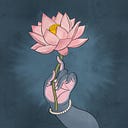Gupta Sculpture of Goddess Gaṅgā

Dry descriptions of iconographical texts cannot help us to appreciate the extraordinary sensuous and graceful forms of Gupta sculptures. As the most eminent poet of the Gupta age, Kālidāsa says:
“Who was the Creator at her making?
Who was the Creator at her making?
How could the Old Ascetic, with interest turned
from beauty of the senses,
Numb from repetition of the Veda,
Construct this figure that delights the heart?”
A well-known sculpture from Besnagar depicting the river goddess Gaṅgā depicts her standing with her hips thrust, exposing her ample breasts, we know at once that few women in real life could be so beautiful. She is all flesh and no bones; she is palpably sensuous and yet somewhat remote. Her limbs are serpentine, her smooth and velvety thighs remind us of the shape of a banana trunk, her eyes imitate the shapes of the leaves above her head. If we were to read about her in an iconographical text, we would learn the meaning of her posture and her attributes. But to appreciate her elegant form as conceived by an unknown master of the Gupta period, we must turn to her description in the Mahābhārata, when the Goddess Gaṅgā appeared before King Śāṃtanu:
“And there he saw one day a beautiful woman who fairly blazed with loveliness, like Śri the lotus goddess come to earth. Her body was flawless, her teeth impeccable, and celestial ornaments adorned her. She was alone wearing a sheer skirt; and she shone like the calyx of a lotus. When he saw her, he shivered, astounded by the perfection of her shape; and this overlord of men could not cease drinking her with his eyes.”
The ideal human body in Sanskrit literature is almost invariably described or eulogized in terms of natural forms. Indians believed that in nature there is a constancy of form that is not present in the human body. The rich metaphors the Indian poet drew from nature became the artist’s models, so to speak, in creating his ideal form: Fingers looked like bean pods, the thighs of women like the trunk of the banana tree or of an elephant, a man’s shoulders like the temple of the bull’s head. Frequently in these figures there are three lines around the neck, because its shape was likened to the conch shell’s, with its three lines. The shape of a nose was to be curved and strong like a parrot’s beak or delicate like the sesame flower. A woman’s face resembled the moon; her eyes, lotuses. Not only do these similes relate to basic shapes, but they also express dominant qualities. Thus, the face shares the moon’s soft radiance, and the eyes open as gently as lotus buds. In fact, in ancient Sanskrit literature, one of the most eloquent ways to express one's appreciation of a woman's walk was: "Oh lady with the large buttocks, your gait is like that of an elephant." The Indian clearly admired the graceful way in which an elephant, and a woman, carry themselves. It might be said that while the exactitude of geometry provided the infrastructure or core, a sense of the flesh was created out of nature's abundance. Indian artists distilled and transformed the essence of nature into the limbs of the human body to create the ideal form "in very vibrant stone."
Excerpt from: The Divine Image and Poetic Imagery in Gupta India by Pratapaditya Pal
